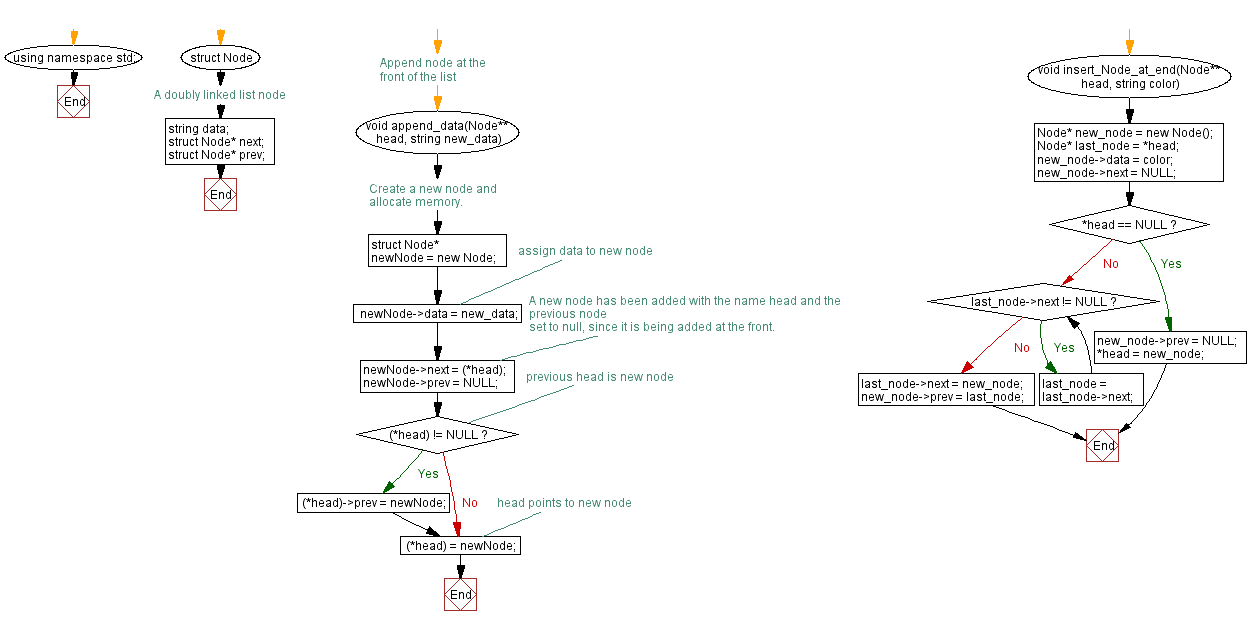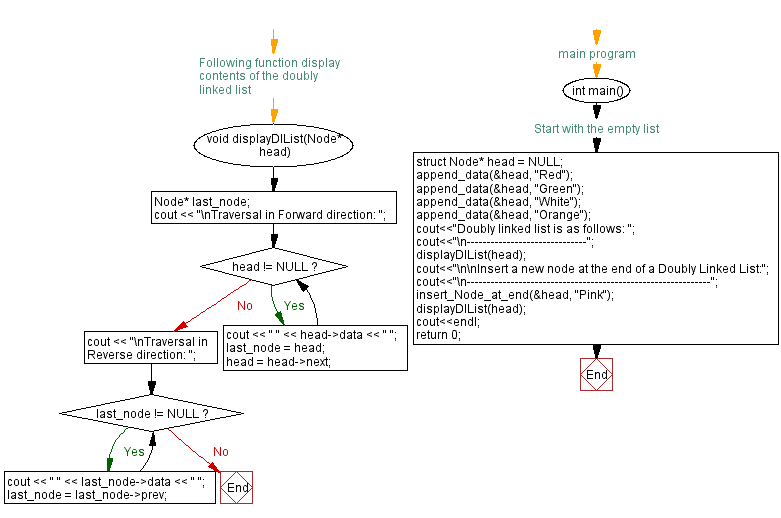C++ Linked List Exercises: Insert a new node at the end of a Doubly Linked List
19. Insert Node at the End of Doubly Linked List
Write a C++ program to insert a new node at the end of a Doubly Linked List.
Test Data:
Doubly linked list is as follows:
------------------------------
Traversal in Forward direction: Orange White Green Red
Traversal in Reverse direction: Red Green White Orange
Insert a new node at the end of a Doubly Linked List:
-------------------------------------------------------------
Traversal in Forward direction: Orange White Green Red Pink
Traversal in Reverse direction: Pink Red Green White Orange
Sample Solution:
C++ Code:
#include <iostream> // Including input-output stream header file
using namespace std; // Using standard namespace
// A doubly linked list node
struct Node {
string data; // Data field to store string data
struct Node* next; // Pointer to the next node
struct Node* prev; // Pointer to the previous node
};
// Function to append data at the front of the doubly linked list
void append_data(Node** head, string new_data)
{
// Create a new node and allocate memory.
struct Node* newNode = new Node;
// Assign data to the new node
newNode->data = new_data;
// A new node has been added with the name head and the previous node
// set to null, since it is being added at the front.
newNode->next = (*head);
newNode->prev = NULL;
// Previous head is the new node
if ((*head) != NULL)
(*head)->prev = newNode;
// Head points to the new node
(*head) = newNode;
}
// Function to insert a new node at the end of the doubly linked list
void insert_Node_at_end(Node** head, string color)
{
Node* new_node = new Node();
Node* last_node = *head;
new_node->data = color;
new_node->next = NULL;
if (*head == NULL) {
new_node->prev = NULL;
*head = new_node;
return;
}
while (last_node->next != NULL)
last_node = last_node->next;
last_node->next = new_node;
new_node->prev = last_node;
return;
}
// Following function displays contents of the doubly linked list
void displayDlList(Node* head)
{
Node* last_node;
cout << "\nTraversal in Forward direction: ";
while (head != NULL) {
cout << " " << head->data << " "; // Displaying data in forward direction
last_node = head;
head = head->next;
}
cout << "\nTraversal in Reverse direction: ";
while (last_node != NULL) {
cout << " " << last_node->data << " "; // Displaying data in reverse direction
last_node = last_node->prev;
}
}
// Main program
int main() {
/* Start with the empty list */
struct Node* head = NULL; // Initializing the head of the linked list as NULL
append_data(&head, "Red"); // Appending "Red" at the front of the list
append_data(&head, "Green"); // Appending "Green" at the front of the list
append_data(&head, "White"); // Appending "White" at the front of the list
append_data(&head, "Orange"); // Appending "Orange" at the front of the list
cout<<"Doubly linked list is as follows: ";
cout<<"\n------------------------------";
displayDlList(head); // Displaying the doubly linked list
cout<<"\n\nInsert a new node at the end of a Doubly Linked List:";
cout<<"\n-------------------------------------------------------------";
insert_Node_at_end(&head, "Pink"); // Inserting "Pink" node at the end of the list
displayDlList(head); // Displaying the updated doubly linked list
cout<<endl;
return 0; // Returning from the main function
}
Sample Output:
Doubly linked list is as follows: ------------------------------ Traversal in Forward direction: Orange White Green Red Traversal in Reverse direction: Red Green White Orange Insert a new node at the end of a Doubly Linked List: ------------------------------------------------------------- Traversal in Forward direction: Orange White Green Red Pink Traversal in Reverse direction: Pink Red Green White Orange
Flowchart:


For more Practice: Solve these Related Problems:
- Write a C++ program to append a node at the end of a doubly linked list and display the list in both forward and reverse order.
- Develop a C++ program that inserts a node at the tail of a doubly linked list and then prints each node's data along with its next pointer.
- Design a C++ program to add a new node at the end of a doubly linked list and verify the tail pointer update by re-traversing the list.
- Implement a C++ program to insert a node at the end of a doubly linked list while handling edge cases such as an initially empty list.
Go to:
PREV : Insert Node at the Beginning of Doubly Linked List.
NEXT : Find the Middle Element of a Doubly Linked List.
C++ Code Editor:
Contribute your code and comments through Disqus.
What is the difficulty level of this exercise?
